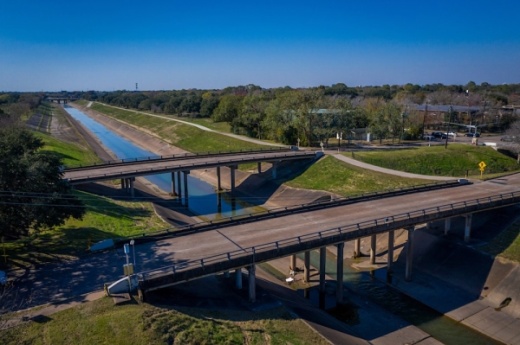“Some people might have said, ‘I’m not seeing any work being done’; well, that might be because we may not have worked in everybody’s neighborhood every time,” said Gary Zika, the federal projects manager for the Harris County Flood Control District. “But something was being done, somewhere—it’s a 31-mile-long bayou.”
For Meyerland and West University-area residents, the uproar has been the opposite, as project planners look to replace some of these communities’ most frequently traveled bridges over the bayou in 2020 and 2021. A swell of public feedback over the design and traffic impact has prompted a full review of those plans.
Meanwhile, efforts by Bellaire and West University in 2020 will build on previous studies to pinpoint how these cities might be able to deliver even more flood reduction on a street level.
Two bridges too far?
City of Houston and Harris County officials have scrapped their original plans for the demolition and reconstruction of two sets of Brays Bayou bridges—on South Rice Avenue and Chimney Rock Road—after community concerns reached a high point in December. The projects were removed from a bid package slated for January.
“I’ve been hammering the city since January on this—that we really look at taking into account a better design for traffic as well as flood protection, but recently the community has really stepped up and is saying the same thing,” Brays Bayou Association President Charles Goforth said. “Now it appears we are being listened to.”
Originally, the bridges were to be taken down one span at a time, allowing traffic to continue flowing both ways over the bayou during construction. However, because of the elevation required to raise the bridges and extend them, a revision to the plan meant the entire bridge intersection would have to be taken offline for a construction period lasting around nine months to a year. That change triggered the uproar in December.
“It would have cut us off from half of our neighborhood for the better part of a year,” said Rabbi Gidon Moskovitz, who leads the Meyerland Minyan congregation on Chimney Rock. To observe the Sabbath, members of the synagogue walk to attend service and many use the bridge, he said.
“Not only that, the businesses along here could also suffer, and the traffic would be a nightmare,” Moskovitz said.
To implement a different design for the bridges—Goforth suggested building one, two-way bridge span for each, similar to the Beechnut Street and Chimney Rock intersection—the city of Houston would have to provide additional funds because the federal project is set up to replace existing structures with equivalent designs, Zika said.
According to a statement from Goforth, the city has agreed to find a way to keep the bridge open throughout construction and implement the single-span design for Chimney Rock and South Rice, but details on the financial commitment were not yet determined. Zika said the project could go out for bids by the summer.
An added bonus of a new bridge design could also mean the intersection could be safer, Goforth said, with one set of traffic lights on either end of each bridge span rather than two, which confused some drivers.
One source of funds would be the Metropolitan Transit Authority of Harris County’s General Mobility Program, Zika said, which was already being used to add 10-foot sidewalks to the reconstructed bridges.
Even with a design change, Zika said the overall timeline will not change because the bridges could be worked on simultaneously, as the agency may not have to shut down the entire crossing during construction.
Bellaire expands its scope
As the federal project winds down, Bellaire and West University Place have commissioned studies to lay the early groundwork that could lead to bond elections to deploy more aggressive flood-reduction strategies between the bayou and the city’s storm drains.
Bellaire City Council formally approved a master drainage study in November, a partnership in the works for months between the Texas Department of Transportation and the Harris County Flood Control District.
The study is an extension of a smaller-scale effort in 2016 that led to some of the projects in the Bonds for Better Bellaire program. This time, the scope is wider, and the price tag—over $700,000—is shared across the other partners.
“This will give us a preliminary assessment of the capital improvements that can be feasibly undertaken that would alleviate flooding from the most common rain events,” Bellaire City Manager Paul Hofmann said. Such improvements could include an underground tunnel—costing upward of $200 million—to more effectively carry runoff into Brays Bayou.
“Likely we’re talking about significant expenses that will require new debt capacity,” Hofmann said.
Mayor Andrew Friedberg noted Bellaire would likely not be expected to shoulder these costs alone.
“The study is an essential step toward being able to compete for grants and federal dollars for the biggest projects that are possible,” he said. “The study could also be of use to our partners, the city of Houston, and others in the watershed.”
Having TxDOT involved is a signal the agency is willing to acknowledge and revisit how longstanding projects such as Loop 610 contribute to flooding, Friedberg said.
“The 610 drainage system was designed in the ‘50s and ‘60s, and it may need to be reconsidered. And they’re acknowledging that, yes, perhaps the Loop does function as a dam and blocks drainage,” he said.
West U takes a deep dive
Just a few weeks after Bellaire officially launched its study, West University Place City Council approved a contract Dec. 9 to evaluate the city’s drainage system taking into account new rainfall rates—as measured by the Atlas 14 guidelines—as well as identify potential projects.
“The thought was Project Brays would remove all of West U from the 100-year flood plain ... but until there’s hard data, that’s all hearsay,” City Manager Dave Beach said. “With Atlas 14, and factoring in the project itself, it’s hard to say what the maps will look like in a few years.”
A small section of West University sits in the 100-year flood plain, according to federal flood maps developed over a decade ago. Most of the city sits in the 500-year flood plain.
In the meantime, the city has hired a consulting firm to create a comprehensive virtual model of its entire storm drainage network to simulate how it would handle various rain events. City Council approved the $188,000 contract Dec. 9.
The study will add more detail and clarity to the city’s 2018 study, which provided more of a broad overview of its drainage system, Beach said.
“This is a much deeper dive,” he said.
That 2018 study, commissioned after Hurricane Harvey, found about half of West University’s storm drains met the criteria for handling a two-year storm, or rainfall that has a 50% chance of occurring any year.
“Some of those streets don’t meet the standard, but that doesn’t mean that they flooded in Harvey. This study will give us more detail and help us prioritize which streets need to be addressed first,” Beach said.
The study will also give recommendations on projects and will provide updated cost estimates to reflect the market rates for construction and materials, which Beach said have been rising as a result of the increased demand for drainage project expertise.
“Long term, the study will be useful because the model won’t change; we’ll just update the variables for storms as needed,” Beach said.





